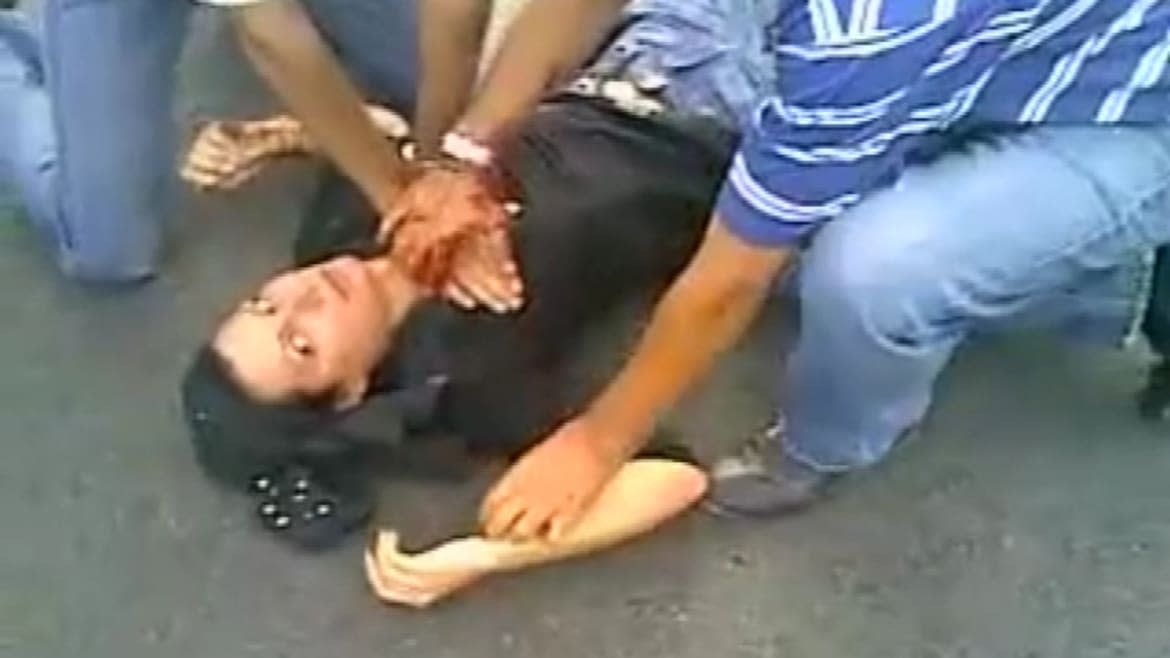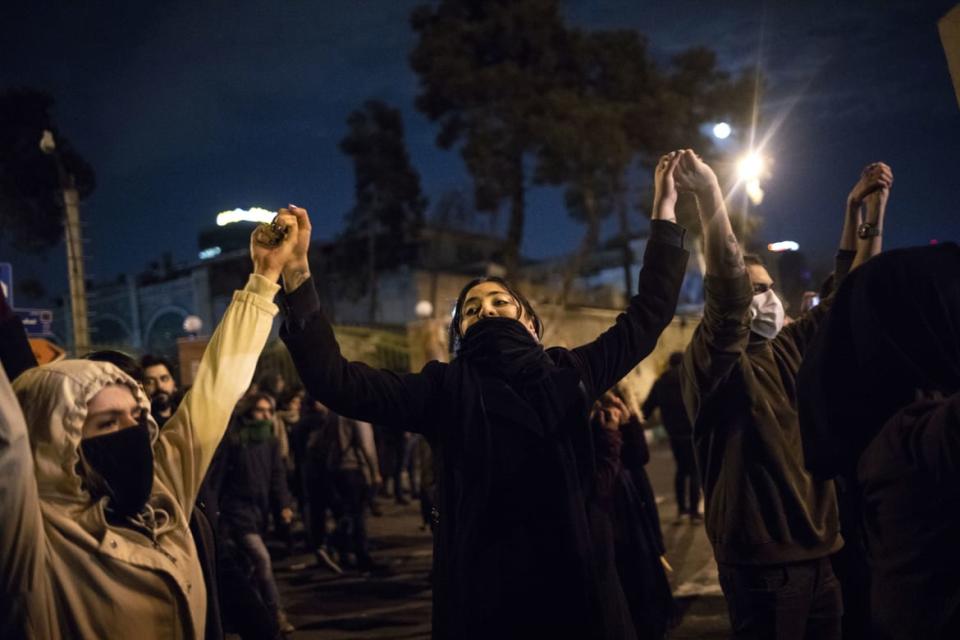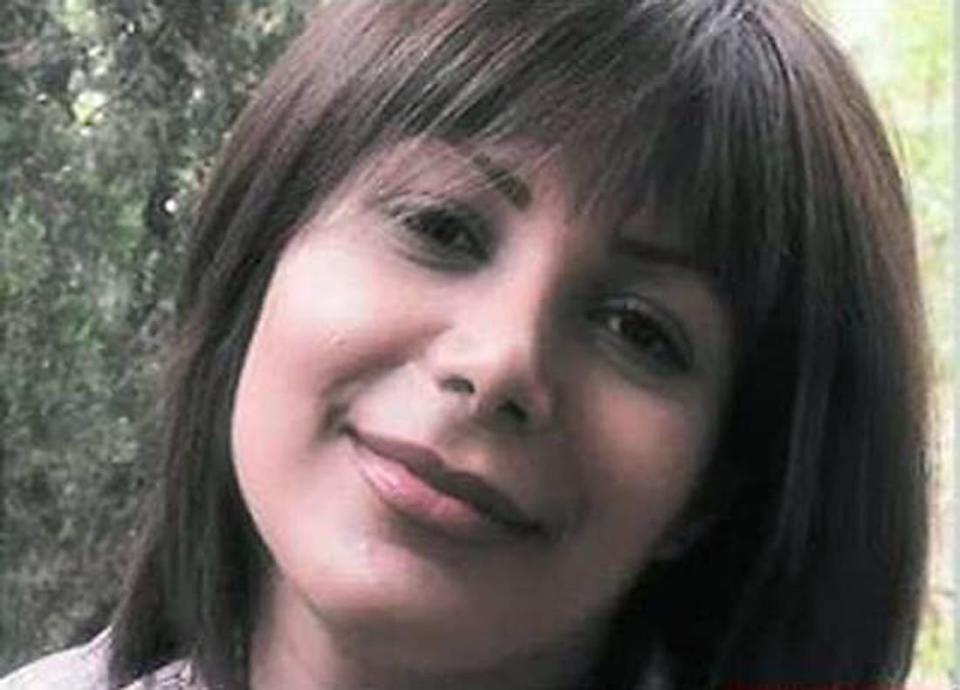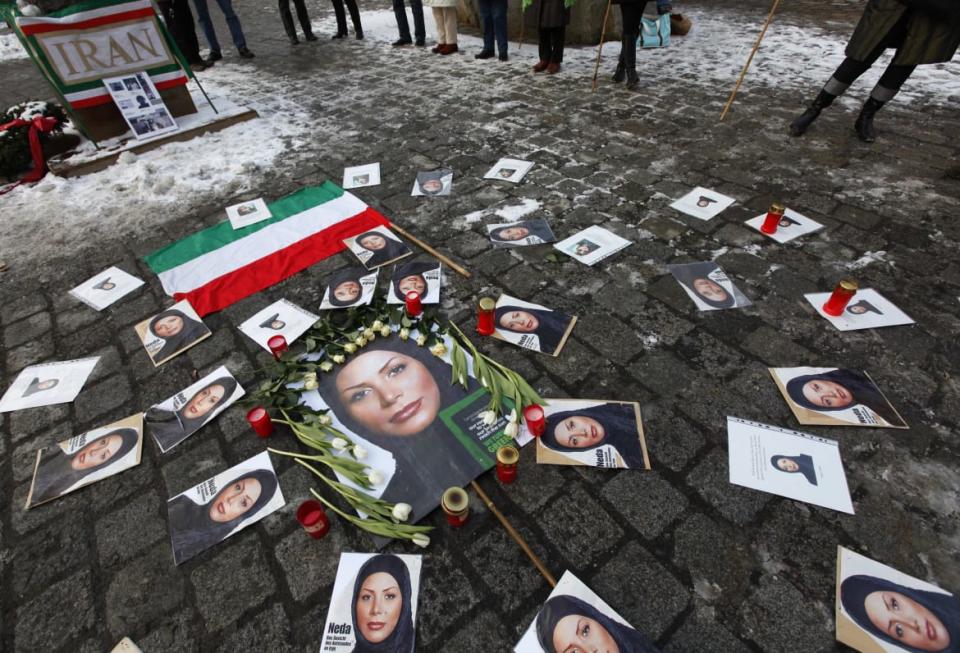Neda Agha-Soltan’s Blood Stained the Ground Where Iranians Protest Today

When politicians and pundits speak of “Iran” and “the Iranians,” they often mean just the Islamist thugs who rule that nation by institutionalized terror.
But Iran and the Iranians also include the protesters who brave batons and bullets in the streets of Tehran, proving themselves as desirous of freedom as any Americans in America.
The most recent protests began on Sunday at a vigil for the 176 innocents who perished when a Ukraine International Airlines passenger jet was downed by an Iranian missile. The regime had initially denied any responsibility for the tragedy, but finally admitted the truth.
The people at the vigil—as much or more representative of Iran as any mullah—are so decent as to be outraged that such a lie had been told by their government. The regime responded, as often before, by battering and tear-gassing and, by several accounts, firing live ammunition at the demonstrators.

Iranians hold hands during a demonstration after Iran admitted to having shot down a Ukrainian passenger jet by mistake.
One noticeable difference from the demonstrations of a decade past was that women were reported to be at the forefront, some of them holding up flowers in the face of assault rifles. A video that made it through the regime’s social media filters shows a wounded woman being assisted by fellow protesters.
“They shot her with a bullet,” someone can be heard saying in Farsi.
Other images that made it online are of blood-stained concrete said to be in the vicinity of Azadi Square.
“The blood of our people!” someone was recorded exclaiming.
The saving of that blood at the edge of a square whose name means “freedom” brought to mind a decade-old video taken a short distance away showing the final moments of 26-year-old Neda Agha-Soltan. She was an aspiring musician and photographer standing at the fringe of the demonstration with her piano teacher on June 20, 2009, when a militia sniper on a nearby roof shot her in the chest. An onlooker’s cellphone footage recorded her final words.
“I’m burning! I’m burning!” she said in Farsi.
Her eyes rolled back as blood then gushed from her mouth and nose. The video that vividly captured it all went mega viral.
“Probably the most widely witnessed death in human history,” Time magazine later said.
Aerospace Chief Says He Wishes He Was Dead After Iran Admits Shooting Down Ukraine Jet
At the time, Agha-Soltan had plans to spend her life with a photographer/filmmaker/journalist/poet/antiquarian/naturalist named Caspian Makan. They had met two months before, in what might be called a case of love at first sound after they chanced to board the same bus in Turkey.
“There were really beautiful sights on the road,” Makan later told The Daily Beast. “I was taking pictures of a rainbow and heard a beautiful voice of a young lady from the backseat talking to me about the beauties of nature. We had more than one hour of very warm conversation without being able to see each other’s faces because of the seats’ positions.”
Only when the bus arrived at Kusadasi was first sound followed by his first sight of Agha-Soltan. Even the given name was perfect for this woman whose beauty he heard before he saw.
“Neda in Persian means: inner voice or spiritual voice,” Caspian later told The Daily Beast.
They proved to have flown in on the same plane from Iran, he to photograph ancient artifacts, she simply on vacation.
“We were together in Turkey for nine days and we were happy that we had found each other as we had many things in common,” he recalled. “We went back to Iran, and our relationship got more serious. And we started living in my apartment together.”
Love at first sound was leading to two becoming one. She hoped one would then become three.
“It was her wish for us to have a baby so much that we even had chosen a name for it,” he recalled.
The choice was accompanied by a hunch regarding the gender.
“We chose ‘Joupin’ as a boy's name, because we thought so!” he said.

Neda Agha-Soltan in an undated photo.
That June, Iran’s hardline president, Mahmoud Ahmadinejad, ran for another term in what was widely viewed as a rigged election. Neda Agha-Soltan was one of an estimated 500,000 Iranians who took to the streets in protest despite warnings from the regime’s supreme leader, Ali Khamenei.
“A day before, dictator ‘Mullah Khamenei’ in his speech, had instructed the forces to crack down the protesters,” Makan recalled.
Agha-Soltan was among those who vowed not to be intimidated.
“She said, ‘I’ll go! Even if a bullet hit my heart,’” Makan remembered.
Makan says that he ventured on his own into the crowds to take pictures even though photographers had been banned.
“The [security forces] were brutally hitting everyone who were on their way, even those who were just passing through,” he later reported. “They threw an old lady on the ground who was hardly able to stand on her feet with a cane in her hand. They were breaking the windows of the houses and cars with their batons to give people fright.”
The bad became dire.
“The security forces started shooting at people and the clashes were intensified,” Makan later said. “I got more worried about Neda. The telephone lines were disconnected in the areas clashes were happening. There was no way to communicate.”
Twelve hours later, his cellphone rang. The display said Neda was calling, but it was her sister, Hoda.
“Caspian, Neda is gone,” she said, by his account.
“What do you mean Neda’s gone!?” he asked.
“She got shot,” the sister said.
Makan began screaming. Agha-Soltan’s mother, Zohreah, came on the line.
“Caspian, they took Neda away from us,” she said.
The regime forbade any memorial service for this young woman whose death was witnessed by millions.
“We were not even allowed to hold a private memorial for Neda in her parents' house,” Makan reported.
Only a few loved ones were permitted at the burial in grave #32 at Behesht-e Zahra Cemetery in Tehran. There came what he describes as “the most painful moments in my life.”
“I was standing right next to her body,” he would remember. “I couldn’t believe that she was my Neda. Her face was strangely in pain and it looked so sad.”
His love at first sound was forever silenced.
“Neda had sang for me a few times, and she seriously had a nice and pleasant voice even when she was just talking!” Makan said later. “I wish I had her voice now. We had decided to record her voice in an audio studio reading some of my poems. But she was gone before her wishes came true.”

But in the days ahead, protesters came by the thousands to the grave. The security forces dispersed them again and again.
“People were getting attacked, arrested, and at least one person got killed at her grave,” Makan said.
The security forces even turned their guns on the grave itself.
“You can’t believe the guards shot at her gravestone and disrespected her,” Makan said.
Six days after Agha-Soltan’s killing, the security forces raided Makan’s home, setting up snipers on the surrounding rooftops. His archive of photographs—10,000 largely of nature and historical sites—were seized. He was thrown into Evin prison. He spent a fortnight in cell #34, often wishing he had himself been killed and buried near grave #32.
Makan was blindfolded when taken to other parts of the prison, but the ears that had once thrilled at Agha-Soltan’s sweet tones were filled with the screams of protesters under interrogation. His own interrogation swung between being hit and being offered ice cream and being threatened with execution as his captors pressured him to say that Agha-Soltan had been on a suicide mission for a subversive group. The regime in the meantime had been making the bizarre claim that she and other demonstrators had secreted vials of blood in their mouths so they could make it look like they were bleeding internally as they sprawled on the street.
Thanks to pressure from Amnesty International and others, he was granted bail. Agha-Soltan had loved sunrises and and he began visiting her grave at daybreak, slipping away before the guards arrived. He did not want to leave Iran and the cause for which she died, but he understood that he would be thrown back in prison if he did not keep quiet.
He finally was unable to endure the enforced silence. He went to Turkey, where he had first met Agha-Soltan, but this time continued on to Canada despite the regime’s efforts to have the Turkish authorities return him to Iran. He pledged to continue wearing black in memory of Agha-Soltan and all the other victims of the regime.
In November of last year, a hike in gasoline prices was met by protests in Tehran and other cities across Iran where people stopped their cars and simply sat. The security forces responded by murdering hundreds, perhaps more than 1,500. As many as a third of them were women.
“Neda planted herself in the ground like a seed!” Makan told The Daily Beast, “Now, we are seeing the other young people, especially girls, growing on Neda’s plant and bravely standing against the religious dictatorship regime... So Neda’s way has continued.”
Among the dead was 14-year-old Nikta Esfandani, who loved music and theater. She was fatally shot in the head on Nov. 16. The regime decreed that due to her youth, the family would not be billed for the cost of the bullet, as was standard practice. She was buried in the same cemetery as Agha-Soltan.
Thousands more protesters were reportedly jailed, many in the same prison where Makan was held.
“I know very well what the hell is there!” he told The Daily Beast. “Every moment I wish I was killed like my fiancée in the street instead of being arrested!”
Women were even more at the forefront of the protests that began on Sunday. A young woman’s blood was again spilled at the edge of Azadi Square.
This week, Makan said he would continue to wear black so long as Iran is controlled by a regime he calls “the original version of ISIS.” A message was posted online by someone who identified herself as Agha-Soltan’s sister and speaks as an Iranian of the Iran that survives despite the regime.
“I am alive but my sister was killed. She wanted the wind to blow into her hair; she wanted to be free; she wanted to hold her head high up and say: I am Iranian. My sister died because there is no life left; my sister died because there is no end to tyranny.”
Get our top stories in your inbox every day. Sign up now!
Daily Beast Membership: Beast Inside goes deeper on the stories that matter to you. Learn more.

